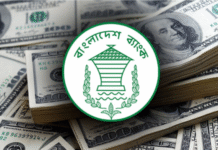
Bangladesh failed to achieve its export target for last fiscal year (2012-13) having a shortfall of US$ 981.74 million although the export earnings witnessed 11.18 percent growth over the previous fiscal (2011-12).
According to the Export Promotion Bureau (EPB), Bangladesh fetched $ 27,018.26 million from export in the last fiscal against the strategic target of $ 28,000 million. The figure represents 3.51 percent shortfall over the target.
The single-month export figure $ 2,696.36 million in June also fell 5.02 percent short of the target of $ 2,839.00 million, showing a 16.31 percent growth.
The total export earnings during the (2011-12) fiscal stood at $ 24,301.90 million compared to $ 22,924.38 million in the previous fiscal year (2010-11).
Talking to UNB, Exporters Association of Bangladesh (EAB) president Abdus Salam Murshedy said that considering the current strength and capability of the country’s export-oriented sectors, securing double digit growth is nothing abnormal for Bangladesh.
“But, to me, the main reasons behind not attaining the export target for FY 13 are political unrest and two tragic incidents of Tazreen Garment fire and Rana Plaza building collapse in between six months put heavy pressure on the country, causing image crisis abroad and exporters facing challenges,” he added.
Murshedy, also a former president of Bangladesh Garment Manufacturers and Exporters Association (BGMEA), said that the international buyers are also under pressure for these reasons while the labour unrest in and around the capital, especially in Ashulia, is forcing the RMG industries to lose their competitive edge.
Asked about the challenges ahead of the government and the industry owners in the current fiscal year, he said although it is the election year, hopefully there will be political stability for the sake of the export-oriented sector.
The EAB president suggested immediate policy support to the exporters, initiating prompt steps to form garment ‘palli’ (village) and starting the work of the Special Economic Zones.
He also hoped that the US government would restore the suspended GSP facilities in due time as both the government and the stakeholders are very much sincere to this end.
According to the EPB statistics for the last fiscal year (2012-13), woven garments fetched the bulk of the export earnings with $ 11,039.85 million that represents a moderate 14.96 percent growth over the same period of 2011-12 fiscal while knitwear accounted for $ 10,475.88 million having a growth of 10.43 percent.
During the July-June period of FY 13, the export of home textiles totaled $ 791.52 million falling by 12.64 percent; footwear exports fetched $ 419.32 million; primary commodities $ 1,079.58 million; frozen foods including frozen fish, shrimps and others $ 543.84 million; and agricultural products $ 535.74 million.
Of the other major performing commodities, fruit exports totaled $ 71.89 million with a 25.77 percent growth; computer services (July-May) 92.53 million having 30.67 percent growth; cement, salt and stone $ 6.15 million while tea export accounted for $ 2.44 million with a 27.81 percent fall.
The export trend for leather and leather products except plastic products maintained their upward trend during the July-June period of last fiscal.
Leather exports totaled $ 399.73 million, while leather products $ 161.62 million, cotton and cotton products together earned $ 124.96 million, plastic products $ 84.51 million and rubber fetched $ 13.57 million.
The export of jute and jute goods during the FY 13 increased to $ 1,030.61 million, registering a 6.54 percent growth. Raw jute exports fetched $ 229.92 million with a 13.65 percent decline, jute yarn and twine $ 506.74 million, and other items brought some $ 56.53 million.
Jute sacks and bags, however, notched a growth of 26.18 percent as exports totaled $ 237.42 million.
Engineering products, including iron and steel, bicycle and electronic products fetched almost $ 367.47 million. Engineering equipments fetched $ 48.73 million with a fall of 1.64 percent.
The export of manmade filaments and staple fibres totaled $ 101.45 million, while the export of ships, boats and floating structures fetched $ 5.73 million suffering a 87.53 percent fall.
The export of handicrafts totaled $ 6.16 million, while paper and paper products $ 33.73 million, furniture $ 31.41 million, chemical products $ 93.01 million (including pharmaceuticals $ 59.82 million), while ores, slag and ash brought $ 22.37 million.
Specialised textiles, including terry towel, showed a negative growth of 10.27 percent, earning $ 124.52 million during the last fiscal year while export of petroleum by-products accounted for just $ 313.95 million.
Meanwhile, silk export notched an eye catching 1700 percent growth fetching $ 0.18 million, followed by export of building materials $ 1.91 million with 496.88 percent growth.









